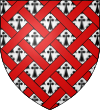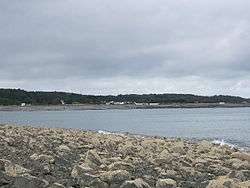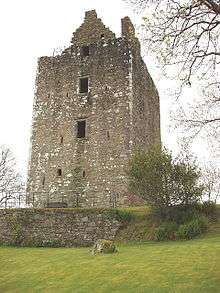Clan McCulloch
| Clan McCulloch | |||
|---|---|---|---|
| Mac Cú Uladh / Mac Cù Uladh | |||
| Motto | Vi Et Animo (From Lat. By strength and courage)[1] | ||
| Profile | |||
| Region | Lowlands | ||
| District | Galloway | ||
| Chief | |||
 | |||
| Stephen McCulloch | |||
| Historic seat | Cardoness Castle.[2] | ||
| Last Chief | The MacCulloch of Myreton. | ||
| |||
| |||


Clan MacCulloch is a Lowland Scottish clan. As it no longer has a Clan chief, Clan MacCulloch is an Armigerous clan.
History
Origins
The name MacCulloch is of Celtic origin and is found mainly in Galloway and Wigtownshire.[3] An alternative derivation has been suggested that the name comes from the Irish Gaelic MacCú'Uladh which means son of the Hound of Ulster and is anglicized as MacCullagh.[3] In Scottish Gaelic the name is rendered as MacCullaich which is translated as son of the boar.[3] The first record of the name MacCulloch swore fealty to Edward I of England in 1296,[4] on the Ragman Rolls.[3] This lineage held the lands of Torhouse, Myreton and Ardwell in Galloway until 1682.[4]
MacCulloch of Myreton (Galloway)

The MacCullochs of Myreton were a Scottish Lowland family who lived in Ardwell, Rhins of Galloway, Wigtownshire overlooking Luce Bay near the Water of Luce. (see location on map on this page). Unlike other MacCulloch families the MacCullochs of Myreton were not septs of another clan but owned their own territory and were later seated at Cardoness Castle. Myreton is in southwest Scotland along the coast. Another MacCulloch region related to Ardwell lies across the bay from Myreton.
Cullo O'Neill was born in Ireland, a son of the family of O'Neills of Clanaboy. Cullo O'Neill served in the army of Edward Bruce, King of Ireland, brother of king Robert the Bruce of Scotland. In around 1316 he was chosen by Edward Bruce as Captain of horse in his army. He later became Sir Cullo O'Neill. In about 1317 king Robert the Bruce of Scotland knighted Captain Cullo og Neil (o’Neil) and chose him to be his standard-bearer and Secretary of State. King Robert the Bruce granted Sir Cullo og Neil the lands of Achawan or Auchwane in Wigtownshire. In 1331 Sir Cullo Og Neil died and left his estate to his eldest son Sir Godfrey, who assumed the surname of MacCullog. (MacCullough / MacCullo’c).[5]
In 1507 the Clan MacCulloch chief ravaged the Isle of Man in revenge for a raid on the town of Kirkcudbright.[3] The Isle of Man was then in the possession of the Earl of Derby.[3]
On 7 July 1618 William McCulloch of Myreton with the consent of his eldest son Alexander, ratified a charter of Killasser in the barony of Achowane to William Houston and his wife Katherine Vaus. The subscript mentioned a new deed of baronia Killasser and the castle.[6]
The chief of the Clan MacCulloch of Myreton was raised to the rank of Baronet in 1634.[3] However this title ended when Sir Godfrey McCulloch was executed in Edinburgh in 1697 for the murder of William Gordon.[3] This may have been as a result of a fight over some cattle.[4] The representation of the family then passed to the MacCullochs of Ardwell.[3] Killasser Castle, the ancient seat of the MacCulloch of Ardwell, is shown on Ainslie's 1782 map as in ruins.[7]
MacCulloch of Oban (Argyll)
Another 'clan' of MacCullochs, the MacCullochs of Oban, lived in the vicinity of Oban, Argyll, and the island of Kerrara, on the West coast of Argyll. Here MacCulloch of Colgin was long recognised as the representative of his line. They were said to be descended from a race of MacLulichs who had lived in Benderloch under the Clan MacDougall.[4] Although the Collins Scottish Clan Encyclopedia states that the MacCullochs of Oban were descendants of the MacDougalls themselves.[3]
MacCulloch of Plaidis (Ross-shire)
Another MacCulloch family, the MacCullochs of Plaidis, established themselves in Easter Ross in the Scottish Highlands by the 14th century. They were first noted as followers of the Earl of Ross and Clan Ross.[4] Several MacCullochs became Canons Regular of the Premonstratensian Order at Fearn Abbey in Ross-shire. In 1486 Angus MacCulloch of Tarell was killed at the Battle of Auldicharish fighting against the Clan Mackay who had long been at feud with the Clan Ross.
In 1497 they aligned themselves as a sept of the Clan Munro in Ross-shire. The family had considerable tenure of lands around Tain. Their principal designation 'of Plaidis' was held until John Macculloch, Provost of Tain, bought the lands of Kindeace from Munro of Culnald in 1612, after which they became 'of Kindeace'. Other lands held by the Maccullochs in Easter Ross included Piltoun, Mulderg and Easter Drumm, the latter coming into their possession in 1649.
MacCulloch Tartans
The MacCullochs of Ross-shire, as septs of the Clan Munro and Clan Ross, are permitted to wear either of those clans' tartans and the MacCullochs of Oban, as septs of the Clan MacDougall, may wear their tartan or even the District of Galloway tartan. However the MacCullochs themselves also have their own clan tartan as well as a second "dress" tartan.
Castles
- Cardoness Castle, which was built in the 1470s, was the seat of the MacCullochs of Myreton.
- Barholm Castle was the seat of a branch of the MacCullochs of Myreton, who became known as the MacCullochs of Barholm.[8]
- Killaser Castle, another seat of the MacCullochs of Myreton in Ardwell, now in ruins.[9][10]
- Myreton Castle was another seat of the MacCullochs of Myreton which was built in the 16th century but was sold to the Clan Maxwell in 1685. The castle was built on the site of a 12th-century motte. Today it lies in ruins.[11][12]
Spelling variations
Although MacCulloch is the most frequently encountered spelling, because few people could write centuries ago, the spelling of the name has varied. This may mean that even members of the same family may have spelled their names differently. Spelling variations include:
- Culloch
- Gulloch
- McCulloch
- McCullough
- MacCoulaghe
- McCullagh
- MacChullach
- MacAlach
- MacCullaigh
- MacCullough
- MacClullich
- MacLullich
- MacLullick
- Makcullocht
- McCully
- McCulley
- McCullah
- McCulla
- MacCulla
- McCullar
- McCuller
- McCullers
- McCullogh
- McCollough
- McCoulough
- McCullock
- McCulligh
See also
References
- ↑ Clan McCulloch Profile scotclans.com. Retrieved 23 March 2014.
- ↑ "Cardoness Castle". Historic Scotland. Retrieved 2013-02-26.
- 1 2 3 4 5 6 7 8 9 10 Way, George and Squire, Romily. Collins Scottish Clan & Family Encyclopedia. (Foreword by The Rt Hon. The Earl of Elgin KT, Convenor, The Standing Council of Scottish Chiefs). Published in 1994. Pages 430 - 431.
- 1 2 3 4 5 MacCulloch electricscotland.com. Retrieved 5 May 2013.
- ↑ An index, drawn up about the year 1629, of many records of charters, granted by the different sovereigns of Scotland between the years 1309 and 1413, most of which records have been long missing archive.org. Retrieved 5 May 2013.
- ↑ Registrum magni sigilli regum Scotorum The register of the Great seal of Scotland, A.D. 1306-1668 archive.org. Retrieved 5 May 2013.
- ↑ Castellated and Domestic Architecture of Scotland. Volume Five. pp.308-309 archive.org. Retrieved 5 May 2013.
- ↑ Barholm Castle.
- ↑ Killaser Castle, Cairnhandy at Geograph/
- ↑ Killaser Castle at ScotlandsPlaces.
- ↑ Myrton Castle at Gazetteer for Scotland.
- ↑ Castle Photos from Scotland by Eleanor.
External links
- Gateway to Clan MacCulloch of Myreton
- Clan McCulloch Website
- Electric Scotland: MacCulloch
- Chebucto Community Net: Culture, Heritage, Philosophy & Religion: Heritage & Multicultural: Scots in New Scotland (Nova Scotia), Canada: Scottish Clans, Septs of Scottish Clans and Scottish Families within Nova Scotia: Clan MacCulloch